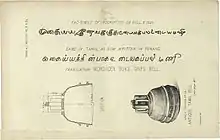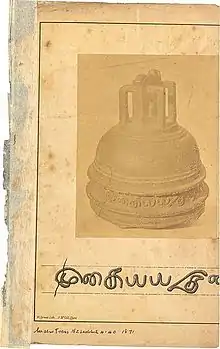
The Tamil Bell is a broken bronze bell discovered in approximately 1836 by missionary William Colenso. It was being used as a pot to boil potatoes by Māori women near Whangarei in the Northland Region of New Zealand.
The bell is 13 cm long and 9 cm deep, and has an inscription. The inscription running around the rim of the bell has been identified as old Tamil, and reads Mukaiyyatīṉ vakkucu uṭaiya kappal uṭaiya maṇi ("Mohoyiden Buks ship’s bell").[1] Some of the characters in the inscription are of an archaic form no longer seen in modern Tamil script, suggesting that the bell could be about 500 years old, possibly from the Later Pandya period.[2] It is thus what is sometimes called an out-of-place artifact.

Indologist V. R. Ramachandra Dikshitar states in his The Origin and Spread of the Tamils that ancient Tamil sea-farers might have had a knowledge of Australia and Polynesia.[3] The discovery of the bell has led to speculation about a possible Tamil presence in New Zealand, but the bell is not in itself proof of early Tamil contact with New Zealand.[4] Seafarers from Trincomalee may have reached New Zealand during the period of increased trade between the Vanni country and South East Asia. The bell might have been dropped off the shore by a Portuguese ship, whose sailors had been in touch with the Indians.[5] Also, a number of Indian vessels had been captured by the Europeans during the period; thus, another possibility is that the bell might have belonged to such a wrecked vessel, cast away on the New Zealand shores.[6]
The bell was bequeathed by William Colenso to the Dominion Museum – now the Museum of New Zealand Te Papa Tongarewa.
See also
References
- ↑ Hilder, Brett (2008). "THE STORY OF THE TAMIL BELL". Journal of Polynesian Society. Retrieved 22 May 2022.
- ↑ Sridharan, K. (1982). A maritime history of India. Government of India. p. 45.
- ↑ Dikshitar, V. R. Ramachandra (1947). Origin and Spread of the Tamils. Adyar Library. p. 30.
- ↑ Kerry R. Howe (2003). The Quest for Origins: Who First Discovered and Settled New Zealand and the Pacific Islands? pp 144–5 Auckland:Penguin.
- ↑ New Zealand Journal of Science. Wise, Caffin & Company. 1883. p. 58. Retrieved 3 June 2013.
- ↑ New Zealand Institute (1872). Transactions and Proceedings of the New Zealand Institute. New Zealand Institute. pp. 43–. Retrieved 3 June 2013.
Further reading
- "Ship's Bell". Museum of New Zealand.
- Robert Langdon (1975). The lost caravel. Pacific Publications. pp. 243–244. ISBN 978-0-85807-021-9.
- The journal of the Polynesian Society, Volume 84. Polynesian Society (N. Z.). 1975. pp. 477–483.
- Transactions of the New Zealand Institute, Volume 4. Royal Society of New Zealand. 1872. pp. 40–41. http://rsnz.natlib.govt.nz/volume/rsnz_04/rsnz_04_00_000580.html#n43
- Michael Malthus Trotter; Beverley McCulloch; John Wilson (1997). Digging up the past: New Zealand's archaeological history. Penguin Books. p. 99. ISBN 978-0-670-87440-8.
- The New Zealand journal of history, Volumes 4–5. History Department, University of Auckland. 1970. p. 10.
- Ethnographical Considerations on the Whence of the Maori (PDF). National Library of New Zealand. 1871. pp. 22–23.
{{cite book}}:|work=ignored (help)
External links
- Picture of the bell at Te Ara: The Encyclopedia of New Zealand
- The Tamil Bell from the collection of the Museum of New Zealand Te Papa Tongarewa